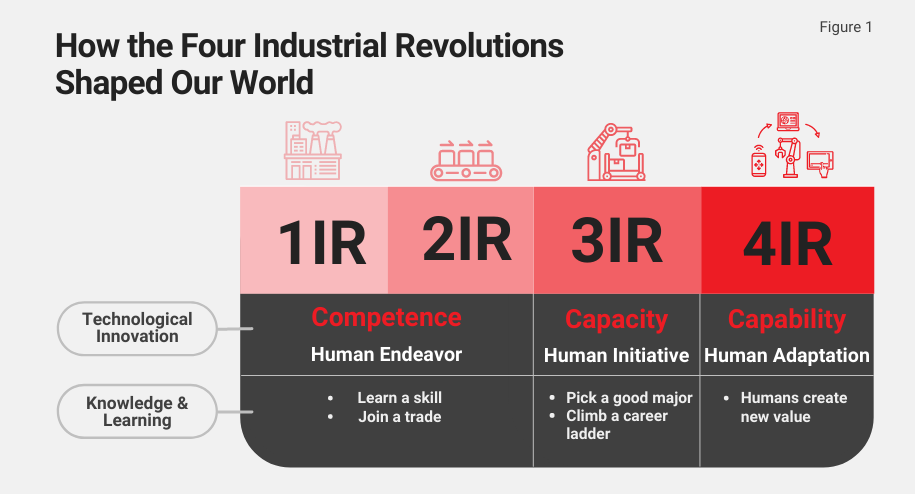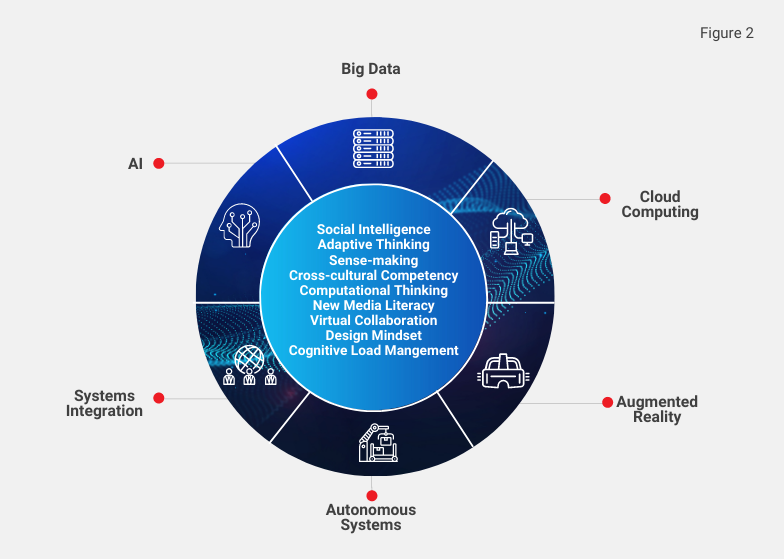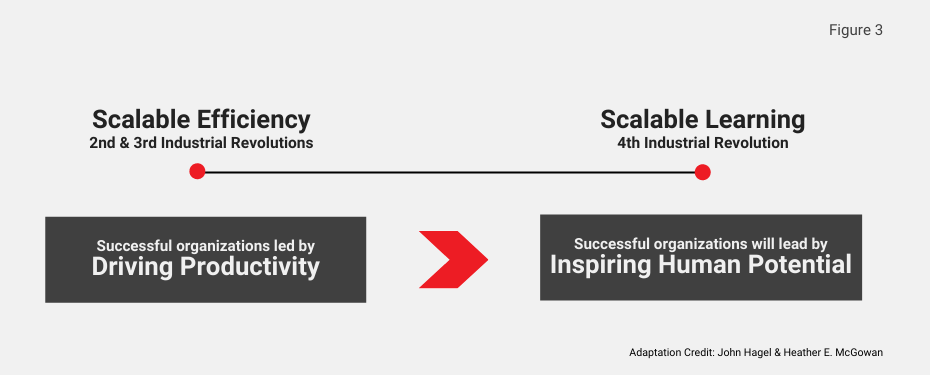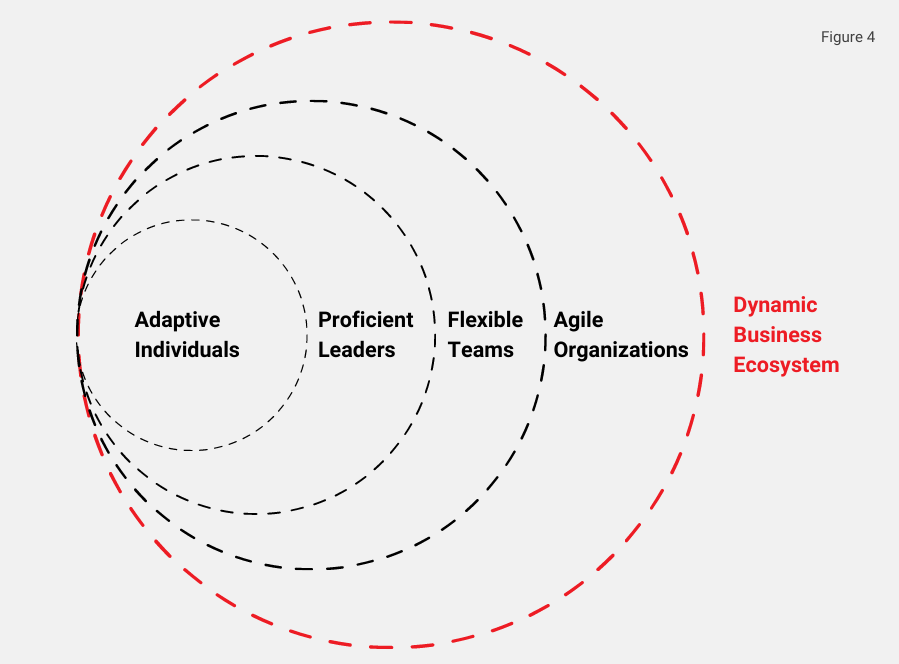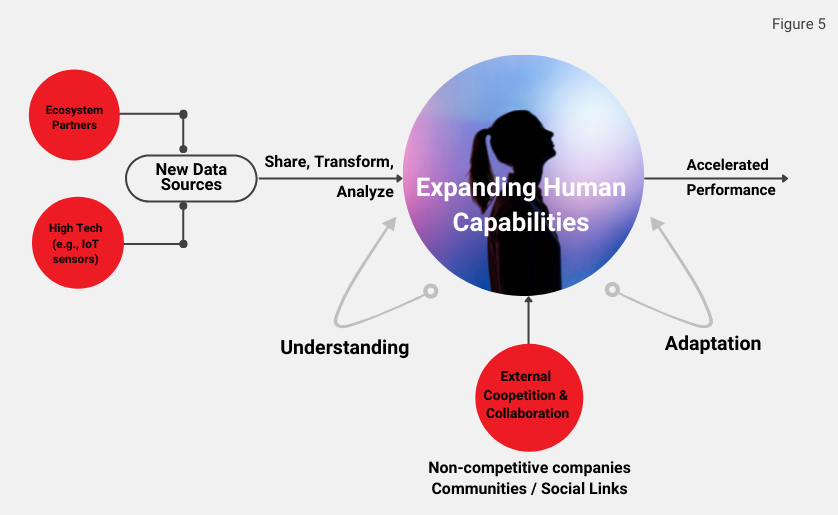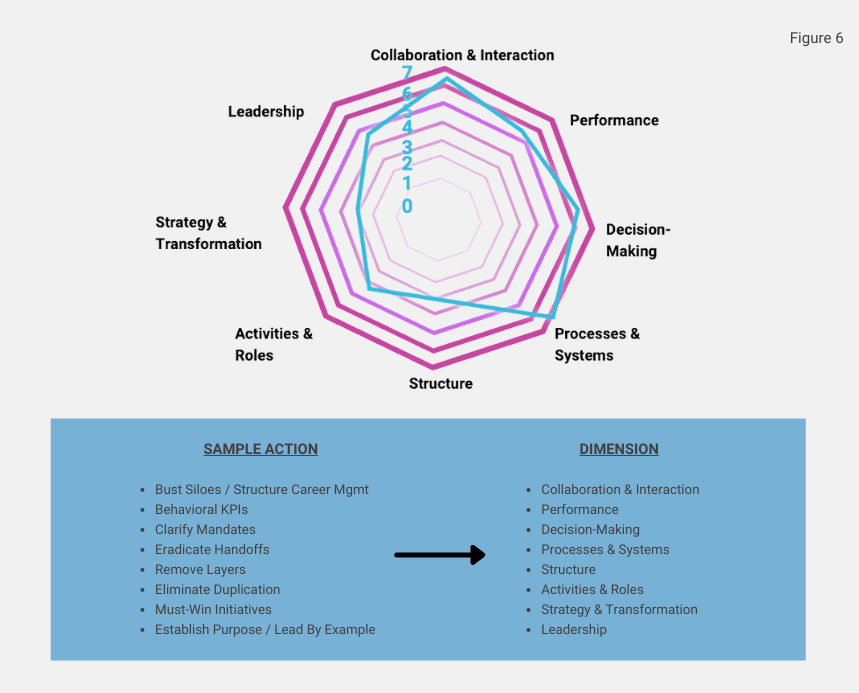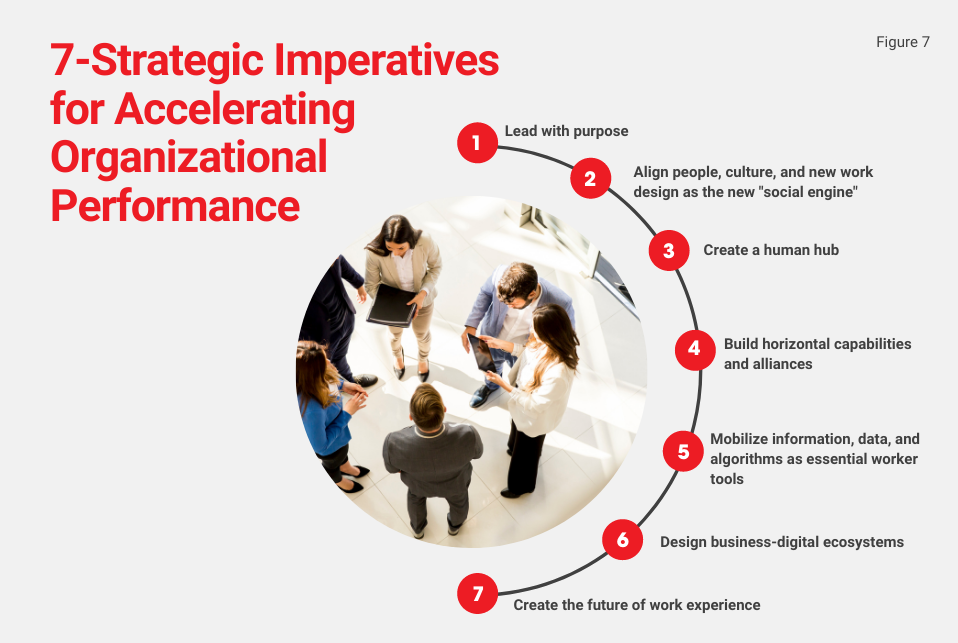Introduction: Why the 4IR Is So Different
To win in this digital age, technology alone is not enough. Success in the Fourth Industrial Revolution (4IR) demands that business leaders create new market spaces that rely on dynamic relationships with ecosystem partners while simultaneously energizing highly productive, autonomous teams through the pursuit of new organizational and cultural systems that break down hierarchies to support rapid and exponential growth models.
Contemporary organizations need to address critical societal and environmental issues that, together with digitalization, are creating the “dynamic stability” that has become the new normal. Much of this tremendous velocity of change is due to the non-linear, exponential, and combinatorial innovation of digital technologies. Along with the right human capital who continually learn, imagine, and breakthrough obstacles, a 4IR organization becomes digital at its core.
While there are ongoing geopolitical and policy challenges, it is apparent that digital, global social, commercial, and data flows will continue to grow exponentially, resulting in an ever more connected and interdependent world. As our “global village” is now built entirely on digital foundations, these predominant social platforms and their communities now exceed the population of most countries.
Even as global environmental forums such as COP26 engage governments to commit to decarbonization targets and to deliver on financial commitments, progressive 4IR companies are setting their sights on net-zero carbon emissions. Increasingly robust ESG metrics are designed to satisfy risk averse investors and citizens who demand transparency and clarity from businesses on these commitments.
Digital transformation, then, is the aggregate impact of these forces. Advanced digital technologies converge with each other and with humans, redefining the purpose and value of human work. Globalization and its interconnected nature bleeds across borders, opening up new markets and rewarding disruptive innovators, often with low costs of entry. The “ticking” climate crisis and concern about future pandemics is inexorably drawing governments, businesses, workers, and citizens into a short-fused core dialogue.
The 4IR and the Human Worker
As shown in Figure 1, the 1st and 2nd Industrial Revolutions tended to follow a rigid ‘learn a skill, join a trade’ formula that emphasized human endeavor and competence (i.e., having sufficient knowledge, strength and skill to do something well enough), and the 3IR leant more towards human capacity (i.e., completion of tasks within specific time-frames). However, the 4IR is a quantum leap ahead, as it demands that workers create new value through adaptation and capability (i.e., the ability to perform a complex set of actions in order to achieve a specified set of outcomes).
Figure 1. The Four Industrial Revolutions
As shown in Figure 1, the 1st and 2nd Industrial Revolutions tended to follow a rigid “learn a skill, join a trade” formula that emphasized human endeavor and competence (i.e., having sufficient knowledge, strength and skill to do something well enough), and the 3IR leant more towards human capacity (i.e., completion of tasks within specific timeframes). However, the 4IR is a quantum leap ahead, as it demands that workers create new value through adaptation and capability (i.e., the ability to perform a complex set of actions in order to achieve a specified set of outcomes).
Today’s organizations can readily acquire and engage top-quality skilled talent from any corner of the world. The pace of change today is so rapid that 4IR workers are challenged to create new value through adaptation and capability by utilizing cerebral and emotional skills that were unnecessary during earlier industrial revolutions.
While much is being touted today about advances in big data, artificial intelligence, cloud computing, augmented reality, and autonomous systems, the 4IR is fundamentally about empowering people and the acceleration of organizational performance. It is as much about advancing human capability as it is about the rise of machine intelligence. Indeed, we live in an era where the pace of change is so fast that workers must constantly adjust to their environment using skills that were largely not needed by employers during earlier industrial revolutions.
As depicted in Figure 2, the future of work will require a multitude of new human-centric skills, including a design mindset, sense-making, advanced cognition, and the ability to collaborate virtually in cross-cultural settings while demonstrating both adaptive and computational thinking.
Figure 2. The 4IR Working Environment
A critical asset of any contemporary worker is the ability to deal with ambiguity – or feeling confident in decisions or actions without the benefit of predictable outcomes. Workers will need the ability and the passion to learn constantly, to be open to diverse opinions and be willing to compromise, to be able to deliver new value to a fast-moving job marketplace, and to be resilient, optimistic, and creative. Today’s business leaders have a pivotal role to play in developing these mindsets, behaviors, and organizational knowledge that will drive human ingenuity while also cultivating the skills that are needed as the digital workplace evolves.
Yet for companies to survive and thrive in this environment, they’ll need to pursue velocity in decision-making – both machine and human – which requires access to high-quality and user-generated data to mine into well-curated and highly contextual insights and learnings. These insights, in turn, enable fast responses to patterns or trends – a capability that’s needed for marketplace agility and adaptability.
Why 4IR Organizations Must Make People a Critical Focus
Historically, most institutions react to market pressures by getting more efficient at ever-larger scale. This involves defining work as tightly specified tasks that can be routinely performed and repeated. Business leaders tend to focus on this scalable efficiency model to drive out cost from the business by adopting one slice of automation to stay ahead of the competition rather than looking at holistic, and more human-centric, solutions.
Successful 4IR leaders, on the other hand, look for holistic solutions that inspire human potential with a mindset driven by curiosity and exploration. This means constantly reskilling the workforce as digital technology advances by adopting what is known as a scalable learning model. This approach involves creating the infrastructure and incentives that will inspire the workforce to pursue new value for the business rather than learning just enough to perform a specific task.
As depicted in Figure 3, human-centricity in 4IR businesses means moving beyond the 2nd and 3rd Industrial Revolutions’ focus on scalable efficiency to the 4IR’s model of scalable learning.
Figure 3. Scalable Efficiency vs. Scalable Learning 1
While it is becoming more widely accepted that the scalable learning approach is a key ingredient for success in a business environment where advances in technology are constantly challenging the human capacity to adapt to rapid change, this can only succeed in accelerating organizational performance when leaders ascribe to the belief that value can be created by workers at all levels of the organization.
Effective scalable learning also requires organizations to tap into information flows, capturing emerging knowledge from sources inside and outside the company. The future of work, for both individuals and organizations, relies on rapid learning, unlearning, and adaptation.
The worker’s ability to adapt to and flourish in an environment of rapid change, as well as collaborate seamlessly with ever more powerful machine counterparts, is crucial to business success in the 4IR. By putting humans in the center of every value proposition, organizations will accelerate performance exponentially.
The Critical Path from the Business Ecosystem to the Individual
To compete in the new world order, companies need to demonstrate the ability to adapt faster than others by continuously evolving their business model. In other words, the ability to think faster and react with tools that embrace entirely new data sources.
As shown in Figure 4, the first layer of the adaptable organization is a broad external business ecosystem. This ecosystem is united by a specific, customer-centric purpose that must constantly evolve in order to remain relevant. Importantly, the horizontal 4IR organization adapts organically to dynamic business ecosystems.
Figure 4. The Transforming Organization – from the Ecosystem to the Individual 4
Leaders must create business environments that allow for constant change, as innovation often comes from creating an ecosystem aligned in culture in which people can connect and adapt in real time.
At the organizational level, an adaptable company must manage scaled efficiency, adopt a flexible governance model, align both formal and informal structures to customer-focused missions, and implement a series of small, incremental iterations rather than major changes.
Adaptable organizations place greater emphasis on the team and unlock individual performance through team composition and new ways of working. Leadership in an adaptable organization is a departure from the traditional, role-based view of leadership. Leaders must exist at all levels of the company and must embrace vulnerability while creating an atmosphere of psychological safety for workers. Leaders must also become inclusive orchestrators and learn to constantly deal with complexity and ambiguity. Growth, learning, and performance management take place on an ongoing basis, and flexibility is a key feature of an individual worker’s career development.
Accelerating Human Performance and Enabling Agility
The 4IR working environment transcends organizational boundaries and leverages cross-industry data sharing and collaboration in order to expand human capability in novel ways. For example, business partners in new horizontal ecosystems, often across multiple industries and sectors, have become intrinsically important to market leaders today, as companies must demonstrate much broader partnerships than traditional linear value chains to flourish in the new world order.
Figure 5. Accelerating Human Performance through Adaptation and Understanding
As shown in Figure 5, this means adopting a cooperative and collaborative approach that spans both organizational and geographical boundaries to embrace non-competitive companies, communities, and other social network links. This in turn provides human workers with new sources of intelligence for the cognitive and creative tasks that are becoming more prevalent as machines usurp tasks that are better performed by machines.
Leading companies are using sources like IoT sensors and business ecosystem partners to mine new data and build a more complete picture of the commercial landscape. The data gathered is then being shared, transformed, and analyzed to realize meaningful insights and actions.
As a result, there are several attributes that enable workers within organizations to expand their capabilities by understanding and adapting to the unprecedented economic, societal, and other shifts that are occurring today. These include the ability for all employees, departments, and groups to collaborate effectively, for workers at all levels to network with others outside the organization and gain new sources of useful knowledge and helpful perspectives, and for workers to demonstrate innovative practices and experimentation without fear of reprisal or marginalization.
Simplifying Organizational Complexity in the 4IR
Transformation strives to remove low-value organizational complexity that saps energy and attention, creates unnecessary stress and risk, and detracts from time needed for necessary complexity. As shown in Figure 6, there are at least eight dimensions of organizational complexity that are typically targeted. These include busting business silos to facilitate greater collaboration and interaction; implementing behavioral KPIs that focus on areas like motivation, satisfaction, commitment, and loyalty; clarifying mandates that allow all stakeholders to agree on the basic purpose of the organization; eradicating handoffs through agile practices; eliminating duplication of tasks; implementing must-win initiatives; and leading by example.
Figure 6. Simplifying Organizational Complexity
Progressive 4IR organizations are agile by design and maintain minimal organizational layers, integrated autonomous teams, and transparency of information and data. When combined with support from leaders who clear paths and share information simultaneously and equitably, teams prosper. Insights stimulate new ideas, generate new energy, and expand individual worker’s capabilities.
Organizational, Individual Worker and Government Imperatives
In the post-pandemic worker experience, leaders must inspire the workforce to embrace inevitable cultural changes by empowering individuals and teams to cultivate growth mindsets. They must support a dynamic, self-directed learning environment that includes a clear mandate to upskill the workforce that is aligned to quantum leaps in technological capabilities.
What should business leaders be doing to grow organizational and human capability? The key is to rethink hiring and retention strategies while blending human talent and new technology to create a “bionic” organization2 driven by a vision of the future workforce.
Secondly, for any organization to remain viable in the emerging 4IR business realm, worker value creation becomes paramount. This is not the world of “learn a skill, join a trade” that epitomized the 1st and 2nd Industrial Revolutions. Having sufficient knowledge, strength, and skill to do something well enough is no longer a benchmark for job security.
Even while the 3rd Industrial Revolution leant more towards human initiative and capacity, such as the completion of complex tasks within specific timeframes, the 4IR demands that workers pursue constant learning, adaptation, agility, and alignment to a new value model that embraces individual creativity and cognition.
Government also has a significant role to play in paving the way for both the digital age economy and enabling sustainable growth. This includes the expansion of digital access by lowering the cost of trade and reducing barriers to market entry, promoting innovation for new job creation, financing technology that enhances the wellbeing of society, and updating regulatory frameworks to embrace global competition.
Strategic Imperatives for Accelerating Organizational Performance
There are seven strategic imperatives that are the essential components for business success in the 4IR. These are leading with purpose; aligning people, culture, and new work design as the contemporary “social engine”; creating a human hub; building horizontal capabilities and alliances; mobilizing information, data, and algorithms as essential worker tools; designing business-digital ecosystems; and creating a future of work experience.
Figure 7. The Seven Strategic Imperatives for Business Success in the 4IR
-
Lead with purpose
The notion of leading with purpose provides the north star to organizational transformation by creating a relationship from individual purpose, the changing nature and purpose of human work, and organizational purpose. Leading with purpose from a business perspective means influencing, inspiring and guiding the workforce with clarity, focus, and the confidence to act regardless of circumstance.
This is a complex topic that involves academic, business and psychological considerations; but the bottom line is that to be a truly effective leader, it is essential to clarify your individual purpose and put it to work in a way that inspires everyone within your organization to find meaning in their daily endeavors. Business purpose begins with intentions, but is realized through how the company operates and the decisions it makes. Perhaps George Bernard Shaw put it most succinctly when, to paraphrase, he said “The true joy in life is being used for a purpose recognized by yourself as a mighty one.”
-
Align people, culture, and new work design as the new “social engine”
The second strategic imperative involves using people, culture, new ways of working, and new work design to form a powerful social engine. By this we mean that work is redesigned to maximize technology by eliminating routine tasks, using algorithms to automate decisions, and providing metrics and learnings to guide decision-making. Through culture and awareness of environmental, social and governmental prerogatives, a company can drive continuous innovation, superior customer service, human-centered design, and business models that are in sync with ESG priorities. Putting the right people in place means combining highly diverse values, behaviors, talent, and skills.
We find that in digital organizations, structure only goes so far. Success ultimately depends on the quality of people and teams. Social engines make work and insights transparent to all workers. New ways of working are instantiated as reliable work practices and behaviors, and innovation and execution are personalized for all customers.
-
Create a human hub
The digital workplace must become the strategic “Human Hub” in the business-digital ecosystem. In other words, the digital workplace must become a personalized “front door” to the people, places, and things that workers need the most. It must embrace all digital capabilities and emerging technologies, including productivity tools, autonomous systems, user data, dashboards and analytical tools, case management capabilities, and personalized self-service assets.
A seamless digital workplace not only empowers dynamic teams to share, collaborate and connect from anywhere on any device for improved worker engagement, but such a hub is ideal for surfacing content from multiple sources in a cohesive human-centric whole.
-
Build horizontal capabilities and alliances
The fourth strategic imperative involves building horizontal capabilities and alliances that align to organizational strategy, purpose and values. Here, we are looking at a future of work experience by building a digital workplace platform that reinforces a culture of inclusion and inspires innovation. The building blocks of this experience include transformational and purpose-driven initiatives, such as peer-to-peer marketplaces, the engagement of leaders as coaches and advocates, and the adoption of common work practices.
This includes promoting a personalized experience for each worker, which in turn facilitates worker and team productivity, inspires individual career journeys and learning interests, and supports the social engine and maximizes participation.
-
Mobilize information, data, and algorithms as essential worker tools
The fifth strategic imperative focuses on the mobilization of information, data, and algorithms as essential worker tools. This involves learning on fast-acting computerized timescales, which leverages these assets in combination with slower-acting human learning to create a scalable organizational model that reorganizes tasks and roles to maximize the productivity of humans and machines working together. While repetition, memorization, storage, retrieval, analysis, processing, forecasting, calculation, and pattern-matching become the domain of fast-acting machines, humans leverage assets like innate empathy, open-mindedness, complex problem-solving, cultural awareness, critical thinking, and adaptability in order to provide the perfect match to their machine counterparts.
Realization of this imperative entails redesigning processes to embrace innovative work on different timescales, promoting more agility for working on the edges of human-computer interaction, building new durable skills, motivation and mindset for human-computer collaboration, and nurturing a company-wide culture of meaningful human work and engagement.
-
Design business-digital ecosystems
The sixth strategic imperative involves designing business-digital ecosystems that emanate from a digital workplace whose core attributes include content management, targeting and variability, intelligent dashboards, attention management, experience content, and sophisticated search capabilities. The surrounding ecosystem includes learning, case management, workforce data management, time management, and extensive collaboration facilities, coupled with knowledge bases, employee self-service (ESS) and manager self-service (MSS) transactions and data, and other systematically enabled sources that facilitate a high-value working environment.
-
Create the future of work experience
The final strategic imperative for success in the 4IR centers on the creation of a future of work experience that accelerates transformation for workers through an operating model that is fundamentally driven by business purpose, culture, and growth mindsets. This embraces both employee and worker experiences through approaches in cross-disciplinary teaming and personalization, situational awareness, and new management approaches driven by hybrid working environments.
In concert, these seven strategic imperatives form the nucleus of accelerating human performance and advancing human capability in the Fourth Industrial Revolution. They are the key to enabling workers to create new value through a combination of ingenuity and adaptation.
Summary
The first sentence of the World Economic Forum’s Davos Manifesto 2020, entitled “The Universal Purpose of a Company in the Fourth Industrial Revolution,” states that: “A company is more than an economic unit generating wealth. It fulfils human and societal aspirations as part of the broader social system.”
Progressive 4IR companies recognize that they must accelerate organizational performance by advancing human capability through alignment with new, digitally-driven business models, while at the same time adjusting to rapidly evolving global circumstances, even as the velocity of change gathers exponential pace. This new organizational evolution, the reality of continual and disruptive change, and the complexity of new, adaptive ecosystems demand continuous real-time but ever-changing collaboration in order to build models that can withstand the demands of the 4IR in an increasingly complex economic sphere.
This is the backdrop that compels companies to dramatically change their business strategy to compete. Continual adaptation and resiliency are key to survival. Leaders think less about competing in an industry and more about winning in a horizontal, sprawling ecosystem. Purpose, people, and culture drive the very core of the business, necessarily and by design. Organizations shift practices from those previously designed to drive productivity to those that cultivate new ways of working and inspire human potential in flatter structures that operate very close to customers.
Workers, in response, must change their value proposition as well. Adaptability is critical to employability and viability. This requires learning new behaviors and changing mindsets to better align to those ideas that are “fit for future.” To be relevant, workers will understand the value that they offer relative to the new value creation needed in digital-first business and operating models.
Finally, leadership is a must-have catalyst to realizing organizational and human adaptation. Leaders will inspire the workforce to embrace inevitable cultural changes by empowering individuals and teams to cultivate growth mindsets. They’ll support a dynamic, self-directed learning environment that includes a clear mandate to upskill the workforce and create organizational capabilities that are aligned to both quantum leaps in technological capabilities and the irreplaceable value of human ingenuity and creativity.
The contemporary worker’s ability to adapt to and flourish in an environment of rapid change, as well as collaborate seamlessly with ever more powerful machine counterparts, is crucial to business success in the 4IR. By putting people, culture, and new work design at the center of our dynamic business models while removing bureaucratic layers that block the free flow of ideas, we tap into the universal human endeavor to be dissatisfied with the status quo and to creatively search for what’s next.
References
1. McGowan, Heather & Shipley, Chris. 2020. The Adaptation Advantage. John Wiley & Sons.
2. Lesser, Rich et al. 2021. Anatomy of the Bionic Company. BCG.
3. Charam, Ram et al. 2021. Rethinking Competitive Advantage – New Rules for the Digital Age. Random House Business Books.
4. Morieux, Yves & Tollman, Peter. 2014. Six Simple Rules – How to Manage Complexity without Getting Complicated. Harvard Business Review Press.
5. Amir Rahnema et al. 2021. The Adaptable Organization. Deloitte.
6. Sam Ransbotham et al. 2021. The Hidden Cultural Benefits of AI. BCG.
7. Seba, Tony et al. 2020. Rethinking Humanity: Five Foundational Sector Disruptions, the Lifetime of Civilizations and the Coming Age of Freedom. Seba.
8. Verd, Nicky. 2019. Disrupt Yourself of Be Disrupted. NLSA.
Logical Design Solutions (LDS) is a digital strategy and design consultancy to global enterprises. We create experiences that transform business and help people work successfully in the new digital organization. Clients come to LDS because of our reputation for intellectual rigor, our foundation in visionary experience strategy, and our commitment to enabling digital transformation inside the enterprise. Learn More about how LDS has dramatically improved the way that some of the largest corporations in the world do business.

